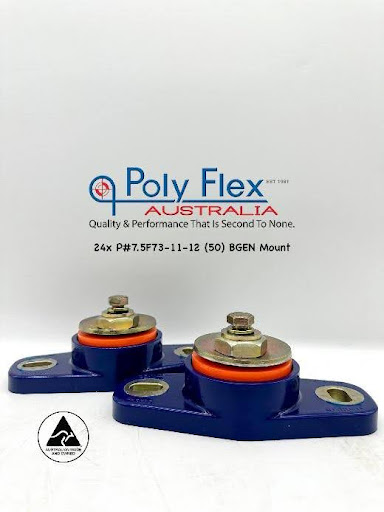An engine mount’s primary purpose is to secure an engine to its anchor point while absorbing shocks and vibrations when in operation, making anti-vibration engine mounts for boats essential for preventing damage to the engine and improving performance. Over time, replacement marine engine mounts will need to be installed to avoid damage to the engine and ensure ongoing user comfort. Understanding when your engine mount systems need replacing is vital to having a smooth engine experience. Below, we outline some critical symptoms of damaged engine mounts for boats, what happens if damaged engine mounts go unchanged, and a few other frequently asked questions regarding marine engine mounting systems.
When Do You Know The Engine Mounts On Your Boat Need Replacing?
Being aware of common symptoms of damaged or worn engine mounts will help you identify if and when replacement mounts are on the agenda:
- Increased Vibrations:
One of the most common symptoms of damaged or worn engine mounts is increased vibration during operation. If your engine is making more noise or you feel more vibration than usual when started, this is a classic sign of worn mounting systems that may need replacing. When engine mounts for boats are damaged or worn, the anti-vibration properties weaken as the mount can no longer perform at 100%. An increase in vibration leads to the engine making more noise, causing damage if left for an extended period.
- Rough Start:
Upon starting your engine, you may notice an excessive lurch that doesn’t feel right. This is another common symptom of damaged marine engine mounts. When running, it may steady into a constant vibration, another telltale sign. You may also experience a lurch when turning the engine off.
- A Rough Ride:
Another common sign that replacement engine mounts for boats are needed is a jolt when changing gears. It is also noticeable when the engine is working harder under load. If your engine doesn’t have the same smooth feeling, a worn engine mount could be the cause.
- Excessive Noise:
Excessive noise from the engine is a by-product of failed mounting systems. The increased movement causes the engine to become misaligned and contact other components, leading to impact sounds that become quite noticeable.
- Visual Wear:
Marine engine mounting systems change in appearance with use. However, the mounts will likely be worn if significant corrosion, cracks, or crumbling are seen. If any cracks or crumbling to the boat’s engine mount properties are noticed, this will limit its performance depending on the severity and root cause. The effectiveness of mounting systems relies on their form and shape, as any changes can damage the engine. If you notice any visual wear on the engine mounts, replacement mounts should be at the top of the agenda.
How Do You Install An Engine Mount On A Boat?
The engine mount is one of the most overlooked components when maintaining a vessel. While engine mounts for boats may not be anything glamorous, this component plays an essential role in the engine room. Engine mounting systems are the connection between the engine’s power and the vessel’s hull, making it crucial to have robust and well-designed engine mounts. However, even the best-quality engine mounts can have problems when incorrectly installed.
The most common reasons for engine mount failure are:
- General wear and tear damage to the rubber/polymer material.
- Metal components damaged by corrosion.
- Improper installation.
- Under sizing.
- Hard shifting.
- Groundings.
- High loading impact/excessive g force caused by running hard in a high sea state.
- Poor vessel structure, such as weak stringers or a flexing hull.
Of the reasons above, improper mount installation is most often the cause of poor engine mount performance. It is important to ensure installation is done correctly. This will ensure your investment is protected, avoid premature engine wear, prevent damage, and, most importantly, improve overall passenger comfort and safety.
How Often Should I Replace The Engine Mounts On My Boat?
Usually, engine mounts for boats tend to last at least 5-7 years, depending on the application. However, getting them checked regularly when maintenance work is conducted is always recommended. Making sure your engine mounts are maintained and alignment is obtained will keep your operating experience as smooth as possible.
Why Should You Use Poly Flex Engine Mounts?

Poly Flex engine mounts are a high quality, high performance, durable and robust true marine propulsion mounting system designed with sufficient vertical deflection to obtain proven vibration isolation with minimum thrust and lateral deflection under load and inertia due to conditions.
Made from a high-quality engineering-grade polyurethane, these mounts prevent rust and are resistant to oil and fuel. They are designed to isolate vibration across the rev range without compromising the alignment of the driveline. Designed as a fail-safe system that is capable of holding the same weight inverted to avoid the engine tearing away from its anchor point in rough conditions or in the event of a capsize.
Poly Flex engine mounts for boats allow for easy replacement of the core and hardware, limiting the need to replace the whole unit. They control thrust in all directions due to the core design being 360 degrees and can handle shock upon impact due to a 400% stretch factor in the polyurethane base material. All the metal components are coated in SA5 Cobalt Zinc, inhibiting rust for extended life, and due to the polyurethane design, no electrolysis occurs between aluminium and steel structures. All Poly Flex engine mounts are Det Norske Veritas (DNV) type approved for vessels in survey. Poly Flex has been providing Australian-made quality and performance that is second to none since 1981, with a strong focus on customer service plans to continue for many more years.



